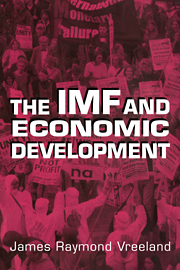Book contents
- Frontmatter
- Contents
- List of Tables and Figures
- Acknowledgements
- 1 Introduction
- 2 Analytically Significant Cases
- 3 An Analytical Approach to the Politics of IMF Agreements
- 4 Testing the Selection Story
- 5 The Effect of IMF Programs on Economic Growth
- 6 Distributional Consequences of IMF Programs
- 7 Conclusions
- Appendix 1 Variables Used in This Study
- Appendix 2 Country-Years in Samples
- References
- Index
4 - Testing the Selection Story
Published online by Cambridge University Press: 08 January 2010
- Frontmatter
- Contents
- List of Tables and Figures
- Acknowledgements
- 1 Introduction
- 2 Analytically Significant Cases
- 3 An Analytical Approach to the Politics of IMF Agreements
- 4 Testing the Selection Story
- 5 The Effect of IMF Programs on Economic Growth
- 6 Distributional Consequences of IMF Programs
- 7 Conclusions
- Appendix 1 Variables Used in This Study
- Appendix 2 Country-Years in Samples
- References
- Index
Summary
The following predictions are generated in Chapter 3: Governments turn to the Fund when their foreign reserve position is weak and they need an IMF loan; they also enter into arrangements when they want conditions to be imposed upon them, subject to sovereignty costs and rejection costs. They are more likely to enter when sovereignty costs are low and rejection costs are high. Governments continue participation in agreements if rejection costs remain high – if other countries are participating. Regarding the decision of the Fund, it is shaped by technocratic and bureaucratic concerns. The Fund is more likely to conclude agreements with countries that have large, destabilizing balance of payments deficits, and more likely to sign agreements when the budget constraint is less binding.
This story is consistent with the anecdotal evidence presented in Chapter 2, but it may apply more generally. To the extent that governments and the IMF enter into agreements according to some systematic patterns, selection is not random. And if selection is not random, then one must control for the possible effects that selection may have on economic growth when estimating the effects of IMF programs. Thus, the task of this chapter is to use a statistical model to test the story of participation in IMF programs to see whether the story applies in general. Results can then be used to control for selection effects in subsequent chapters.
- Type
- Chapter
- Information
- The IMF and Economic Development , pp. 83 - 106Publisher: Cambridge University PressPrint publication year: 2003



